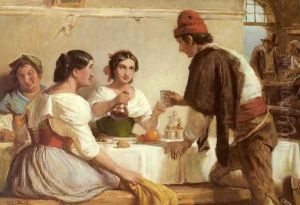Nicolai Wilhelm Marstrand Paintings
Nicolai Wilhelm Marstrand, born on December 24, 1810, in Copenhagen, Denmark, was a prominent Danish painter of the 19th century, known for his depictions of genre scenes, historical subjects, and his role in the Danish Golden Age of painting. Marstrand studied at the Royal Danish Academy of Fine Arts where he was influenced by the teachings of Christoffer Wilhelm Eckersberg, a central figure in Danish art who emphasized the importance of painting from nature and daily life.
Marstrand's early works were often genre scenes filled with wit and humor, depicting the everyday life of Italian people, which he experienced during his extensive travels to Italy. He was profoundly influenced by Italian art and culture, something that remained a constant source of inspiration throughout his career. After winning the Academy's large gold medal in 1836, he was granted a travel scholarship which allowed him to stay in Rome for several years. During this period, Marstrand developed a more free and painting style, and his compositions became more dynamic and colorful.
Upon returning to Denmark, Marstrand enjoyed significant success. He became a professor at the Academy in 1848 and later its director from 1853 to 1857 and again from 1863 to 1873. Marstrand's historical paintings, which often depicted scenes from Danish and Italian history, were particularly appreciated in his home country. His work was characterized by a lively and often humorous representation of his subjects, with a light and vibrant color palette.
Throughout his career, Marstrand remained an integral part of the Danish art community. He continued to produce a significant body of work, including altarpieces for Danish churches and a series of murals for the University of Copenhagen's ceremonial hall, which are considered some of his most important contributions to Danish art.
Nicolai Wilhelm Marstrand passed away on March 25, 1873, in Copenhagen. His legacy is preserved in the collections of the National Gallery of Denmark and other museums in the country, where his works continue to be celebrated for their contribution to the Danish Golden Age of painting.


